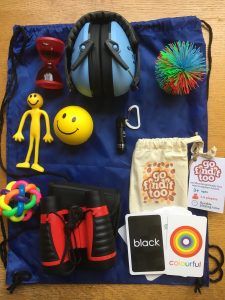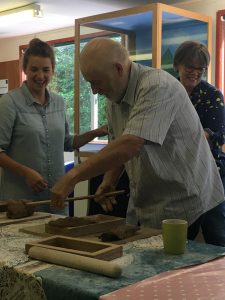Spotlight on: Nikita Brown from Wheal Martyn Clay Works
In the latest installment of our ‘Spotlight on’ blog posts, we hear from Nikita Brown, Exhibition and Engagement Officer at Wheal Martyn Clay Works near St. Austell, about the importance of accessibility in museums.
I believe that museums should act as community hubs, where all members of the community feel confident and safe to voice their opinions and take ownership of the museum and its collections. Improving accessibility is one way I can ensure that all visitors feel welcome at Wheal Martyn and have a fantastic museum experience.
So, what have we been doing at Wheal Martyn?
As Exhibition and Engagement Officer, my first priority was to improve the overall access to the museum for a general visit. Making small changes to the museum has allowed staff to work with more community groups and enhance the visitor experience for those with additional needs, whether this is creating visual stories for people with autism and anxiety, or simply changing how a gate opens to make it more wheelchair accessible.
At Wheal Martyn we have been working with partner organisations to seek expert advice and ensure our accessible information is easy to use. We are fortunate to be one of around twenty heritage destinations taking part in Heritage Ability’s, Heritage Lottery Funded project, which looks to improve accessibility and inclusivity in historical sites. Working in partnership with Heritage Ability, the museum now has a new Easy Read Guide making the site’s information easy to understand for those with learning difficulties, as well as a digital British Sign Language (BSL) tour of the site which can be viewed on YouTube or via a tablet at the museum.
I also received training from Heritage Ability on disability and deaf awareness which I have been able to replicate with other museum staff. We are fortunate to have fantastic, friendly staff at Wheal Martyn who are always willing to go above and beyond to improve visitor’s experience. The training has equipped them with relevant knowledge about how best to help all visitors, regardless of disability or need. It also highlighted the benefits of making small adaptations, such as having hearing loops, which we purchased two of to go in the reception and café.
Becoming an autism-friendly museum
I’m passionate about making attractions and historical sites more autism-friendly, so this was another one of my top priorities when I started working at Wheal Martyn. I started by creating two visual stories of the museum. Visual stories use images and words to show visitors with autism the layout of the museum and what to expect before visiting. An example being how the café can sometimes be busy and have strong smells. Visual stories are really easy to do, so I would encourage all historical sites to give it a go. Once I had finished the visual stories, I then had them checked by Spectrum, who specialise in Autistic Spectrum Disorders, to make sure they were useful for this group of people. I would really recommend seeking expert opinion where possible, as their advice was incredibly helpful and even though I was often on the right lines, it was great to get this confirmed by professionals.
With guidance from Spectrum, I created a quiet space at Wheal Martyn with comfy sofas and bean bags to allow people an area to chill out, if the museum gets too overwhelming for them. Visitors with sensory disorders can also use our sensory backpack, which includes ear defenders, fiddle toys and a sensory game. It’s great to see these bags being used around the site and we have received a lot of positive feedback from our visitors who have enjoyed using them.

In March 2019, Wheal Martyn held its first relaxed opening session which allows families to explore the museum at a quieter pace. Although only a few families attended the first session, the impact the session had on one of the families was huge. It gave them the confidence to return to Wheal Martyn with their extended family during the Easter holidays, giving them an opportunity to enjoy being together as a family. The relaxed sessions take place every quarter, with our next sessions taking place on Saturday 19 October and Saturday 18 January.
Encouraging social group meetings at the museum
With help from our fantastic, committed volunteers, we have started running two new social prescribing groups held at the museum. Arts and Craft for Health which runs every Tuesday morning and a Sensory Garden group which will launch in September. Both groups aim to give those struggling with mental illness or other long term health conditions, the opportunity to develop their confidence and skills in a safe and friendly environment.
The Arts and Craft group consists of participants bringing along their own craft which they would like to work on during the sessions and they have the option of asking the coordinator for help and advice. What I have personally enjoyed witnessing is the participants sharing their craft skills with each other. I am always amazed at how caring and supportive these groups are and I have definitely learned lots of new craft skills from the participants myself!

We have artists regularly holding specialised workshops with the participants, so they have the opportunity to learn a new skill and explore the museum in a new way. Recently, the group has taken part in a sound workshop with artist Justin Wiggan and have even made their own bricks with the Brickfields project (a Whitegold initiative). As Wheal Martyn has an extensive brick collection, it was great to explore these stories in a new way with the participants and everyone was pleased with their brick designs.
The impact the sessions have on the participants is clear to see; confidence is growing, friendships have been formed and the group is always filled with laughter and support for each other. One of the participants who hadn’t drawn since he was at school, has enjoyed the sessions so much, that he has started up his own group on a different day. We also have a Memory Café which meets every second Monday of the month for people suffering from memory loss and their carers. The group consists of a range of informal arts, crafts and reminiscence activities, as well as a nice chat and cuppa!
Looking to the future
Wheal Martyn has a lot more planned over the next few months. Whether it is working with the Sensory Trust to create a sensory map and bespoke workshops for children with additional needs, or trialing live streaming of events to make them more accessible for those who can’t get to the museum. Perhaps the most exciting has to be the opening of our new facilities in April 2020, as part of the Clay Works project which will include a new gallery for temporary exhibitions, a new learning and activity space and a new permanent exhibition on the ‘Transport of China Clay’. The new improvements will also include a lift to access the exhibition space, meaning that more areas of Wheal Martyn will become accessible for wheelchairs.
I aim to embed accessibility in all areas of my work which includes temporary exhibitions where I try to ensure that all senses are stimulated through having a range of different interactives. I think my main learning from the last year is the importance of working with partner organisations for help and advice. Everyone I have contacted has been happy to help and are incredibly passionate about making more sites accessible. If you would like any more information about the projects mentioned above, then I am more than happy to share my learning with other museums.
– Nikita Brown
Exhibition and Engagement Officer, Wheal Martyn Clay Works
https://www.wheal-martyn.com/